Image: Matt Johnson
Fifty years ago, one of the most remarkable tales in world football occurred at the Estadio Nacional in Lisbon. Underdogs Celtic defeated Helenio Herrera’s Inter Milan in the European Cup final in what is still to this day the greatest achievement by a Scottish club side. What made the feat even more special was the fact that all 11 of Jock Stein’s Lisbon Lions were born within a 48-kilometre radius of Celtic Park in Glasgow. In more recent times, Barcelona fielded 11 graduates from their La Masia youth academy during a La Liga fixture against Levante in November 2012, something which the late Dutch icon Johan Cruyff always envisaged when planting his imprint on the ‘chapel’ that propelled much of Barca’s success in the modern era.
These accomplishments epitomised the importance of promoting within and how players born within the institute’s geographical proximity are best placed to guide the club to winning silverware and helping form an identity and bond with supporters alike. Closer to home, the back-to-back NSL Championship-winning Melbourne Knights sides of the mid-90s were comprised almost exclusively of Victorians, with many of the players sharing the club’s Croatian heritage. Similarly, Ange Postecoglou’s back-to-back title-winning squads later that decade at South Melbourne constituted of Victorian-born players, with over 80% of the team born in Melbourne and its surroundings.
The beginning of the A-League in 2005 saw Victoria represented by the Melbourne Victory, with the importance of recruiting local players not lost on key decision-makers at the club. Founding chairman Geoff Lord hired Ernie Merrick as coach ahead of more credentialed options on the basis that the Scotsman’s work at the Victorian Institute of Sport over a decade and a half saw him work with the cream of the crop of the state’s footballing talents.
Subsequently, Victory’s inaugural squad featured 16 Victorians from the 20 players (80%) with Sydney-based defenders Mark Byrnes and Chris Tadrosse the only non-Victorians in the side alongside foreign imports Geoffrey Claeys (Belgium) and Richard Kitzbichler (Austria). Furthermore, the team contained regional representation in the form of Albury-Wodonga’s Archie Thompson, Geelong-raised youngster Adrian Leijer and Tatura’s Vince Lia. That side was recruited to be a team which Melburnians, and broadly Victorians, could identify with in a time of great importance for the game in this country.
Fifteen of the 23 (65%) members in the season two Championship-winning Victory side were Victorian, although the following years saw a gradual decrease in local numbers. The signings of interstate youngsters Evan Berger, Nathan Elasi, Mitchell Langerak and Sebastian Ryall ahead of season three heralded the beginning of a trend in which successive Victory coaches sought to enlist some of the country’s brightest talents outside the state border. The impressive figures from the first two campaigns reduced over the subsequent three years from 52% to 50% to 45% with Merrick’s enforcers claiming their second Championship success in 2009. A rise to 56% of the senior squad in the final season of the Merrick reign coincided with the emergence of several youngsters from Victory’s youth team, which since its inception in 2008 had been led by his successor Mehmet Durakovic.
Yet Durakovic’s half-season stint with Victory saw the figure fall to a low of 44%, with his replacement Jim Magilton contributing to that by number by bringing in Mark Milligan and Spanish defender Ubay Luzardo during the January transfer window.
The arrival of Postecoglou saw a rise back up to 54% as the future Socceroos coach sought to combine some of the state’s best youth players with the most exciting youngsters from across the country with the likes of Jason Geria, Scott Galloway and Jesse Makarounas moving to the Victorian capital during his time at the club. Former captain Kevin Muscat replaced him in the hotseat in the early rounds of the 2013/14 season, which led to a drastic decline over the last four years.
Despite Muscat’s men winning their third Championship in 2014/15, the use of Victorian players reduced during his stewardship from 50% in his debut season to 42% in his first full campaign which yielded the title. The figure then dipped from 40% to 35% over the next two terms and now stands at 29% heading into this season. Thus, Victory’s Victorian contingent has decreased from nearly two-thirds a decade ago to just under one-third in the present. Aside from Leigh Broxham, the other five local players currently in the senior squad have played a total of 23 A-League games between them. While these figures are concerning, the club has at least recently elevated youth team players Cameron McGilp, Christian Theoharous and Pierce Waring (alongside Tasmanian Josh Hope) onto senior contracts, with Victory often criticised for their lack of youth-team promotion.
Yet in nine years of NYL football, only three youth-team graduates have gone onto make over 50 league appearances for the club: Nick Ansell, Diogo Ferreria and Connor Pain. The average number of A-League games amongst them is just 58 matches. In that time, dozens of young hopefuls have plied their trade for the youth team without being afforded a senior team opportunity and ultimately ended up in the relative obscurity that is semi-professional NPL football, with Seb Pasquali a notable exception currently at Jong Ajax.

But Melbourne Victory still fares better than their local rivals Melbourne City in this department, who are seemingly ignoring local youth in favour of proven A-League interstate players, non-Victorian youngsters and a host of foreigners in their attempts to win their first A-League Championship.
Upon coming into the competition in 2010, the then-Melbourne Heart promised to be the ‘purists’ side which housed some of the league’s best footballers in addition to several local teenagers. Socceroos John Alosi, Michael Beauchamp, Dean Heffernan and Matt Thompson joined local legends Simon Colosimo and Josip Skoko at the Bundoora-based Heart, who also set their sights on winning hearts and minds in regional Victoria through the exhibition of several pre-season friendlies in Geelong, Gippsland and Bendigo. Emerging talents Aziz Behich, Nick Kalmar, Kliment Taseski and Adrian Zahra came in from the Victorian Premier League while Kamal Ibrahim returned from his stint at the AIS in Canberra. All in all, 9 out of 23 (39%) first-team members had Victorian roots, a figure which rose the following campaign to 11 out of 25 locals (44%) under Dutchman John van’t Schip.
However, those statistics dipped rapidly under John Aloisi and van’t Schip following his return in January 2014 just weeks before the CFG takeover, with those three seasons seeing the number at a mere 17%. A slight rise to 22% followed the next campaign before last season’s fall to 21% coincided with City’s first major trophy success as star recruit Tim Cahill’s header saw them defeat Sydney FC 1-0 at AAMI Park in late November.
With just three Victorians (13%) on their books prior to the start of this campaign, excluding ‘scholarship’ players, one must question City’s commitments to nurturing the state’s best talents when there are more players from New South Wales (five) and South Australia (four) in the 23-man roster. Since their NYL inception in 2011, Paulo Retre is the only Heart/City youth team graduate to feature over 50 times in the A-League for the club, having made a total of 53 appearances before moving to Sydney FC.
These numbers make for dim viewing to any aspiring young footballers in the state, with Victory and City having the lowest number of local players than any other teams in the league. The four NSW clubs combined have a majority 50 players on their books who originate from Australia’s most populous state. Furthermore, smaller populated states South Australia and Western Australia are well represented in the Adelaide United and Perth Glory squads, with 12 and 10 homegrown players on their lists.
Highly rated Melburnian pair Jake Brimmer and Peter Skapetis have joined the Glory and Brisbane Roar respectively, with both City and Victory reportedly not interested in acquiring their services. In recent weeks, two of NPL Victoria’s brightest young talents Nick Krousoratis and Nikola Jurkovic have trialled with the Wanderers and Adelaide United respectively in pursuit of a professional contract, while interest in the likes of Kenny Athiu and Damian Iaconis appears non-existent.

READ MORE > Division and distrust in NPL as A-League remains closed shop
Perhaps alarmingly, these figures paint a portrait of two clubs ignoring the talent knocking down on their door, although such a phenomenon is not something new. Mathew Leckie was offered to the Victory before his move to Adelaide United. Jackson Irvine elected to move to Scotland to join the Celtic Academy having been on the books of Victory Youth, as was Geelong junior Matthew Spiranovic, who elected to move to Europe at a time when not many teens were coming through in the A-League. Green Gully junior Jamie Maclaren’s return to Australia from the Blackburn Rovers Academy saw him play at the Glory and Brisbane, becoming a star marksman for the latter after being afforded an opportunity which was restricted to him in the West by the presence of Irishman Andy Keogh. Like Maclaren, Ivan Franjic and Sasa Ognenovski had to move to the sunshine state in order to become household A-League names and eventual Socceroos.
With the A-League set to begin its 13th edition this Friday night, certain fans across Victoria and beyond will eagerly await what this season has in store for City and Victory. Both are tipped to be challengers in their own right and both have strong recruitment capabilities. Yet at the heart of most teams in world football is a strong commitment to the geographical area they represent, which ultimately creates a certain identity around that club. Whether City and Victory play their part in fostering such a notion is debatable, especially when looking at the statistics points to a bleak picture to any young aspiring footballers in this state.
Victoria’s U14s won the National Youth Championship in Coffs Harbour recently while the U13s finished runners-up, but ultimately one must wonder whether the next generation of Vidukas, Skokos, Brescianos, Grellas and Kennedys are being lost to the game, victims of a rather fractured and unforgiving scouting network which appears dismissive of those within its very own backyard.

